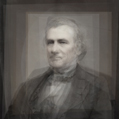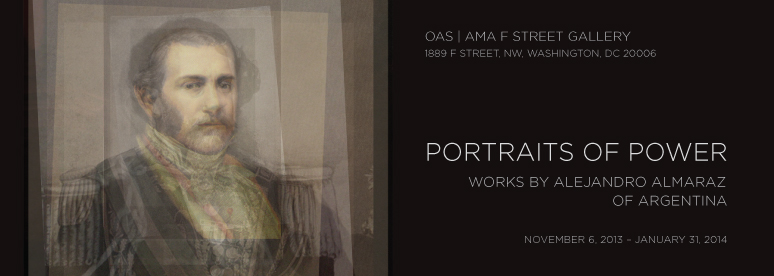F STREET GALLERY EXHIBITION - 1889 F Street, NW

An Anonymity of Power
by Vicki Goldberg
Power always makes its presence known in one way or another. Leaders of a country, a kingdom, an empire reinforce their position and emphasize their dominance by putting before their subjects’ eyes some image of themselves. Pharaohs planted sculptures of their regal selves outside their temples, Roman emperors had their likenesses on coins, Louis XVI of France did too. In the media age, as two-dimensional images proliferated, kings, presidents, and prime ministers began to face their public (or insist their public face them) in state offices, post offices, courts and so on via paint or photograph.
Alejandro Almaraz finds the continuities of authority and its representation by superimposing official portraits of successive presidents and heads of state over long spans of time. Placing somewhere between four and forty images from a single country atop one another, each sufficiently transparent that earlier ones peep through, produces some ghostly and some mildly cubist effects: pale shadows of previous officials linger about the final portrait. The presidents of Iran and of The Democratic People’s Republic of Korea have been blessed with halos by the high military caps of earlier presidents. Abstract shapes turn up behind some faces. Overlapping see-through frames and shapes vaguely suggest the transparent planes of classical cubism. Overlaid rectangles give the odd impression of glass plates laid one upon the other – photography as palimpsest.
The range of dates, as long as from 1826 to 1892 (the presidents of the United Mexican States) and 1789 to 1889 (the presidents of the United States) elasticize photography’s bond to time and virtually erase its link to memory. Abraham Lincoln has disappeared beneath his predecessors and successors, Benito Juarez beneath his. More startling is that Stalin, who himself had many important men wiped out both from life and from the photographic record, has morphed clean out of recognizable existence in this throng, and Mao, whose image reigns eternal in Tiananmen Square, vanishes altogether. These photographs are time capsules that can only be opened by historians.
The fact that more then one of these series begin before photography’s invention and therefore include paintings (which are indistinguishable from the later photographs) points yet again to photography’s continuance of traditional portrait traditions. And then the presentation of officialdom stays remarkably consistent within one nation over many years. The official portrait varies from place to place but very little: almost always bust length -- only the presidents of Chile appear full length, from 1810 to 2008 -- predominantly full face though sometimes slightly turned, and most often with a serious expression.
Seriousness is a given in nineteenth century portraiture, when exposures were longer, but it persists in many countries as a sign of earnestness, dignity, and determination. Not until around 1960 do a few leaders put on smiles of one sort or another to appear approachable and friendly. Vastly different countries turn out to have quite similar ideas of leadership portraits. Though the presidents of any nation change with time, revolutions, coups, politics, elections, and death, the depictions and symbols of authority march on essentially unchanged.
Rulers’ portraits were much more diverse when they were unique and private: consider the sober full-length portrait of Phillip IV of Spain by Velasquez in the Metropolitan Museum in New York, the king’s black garments conferring bulk on his slender frame and making the gold chain with the Order of the Golden Fleece all the more prominent. Or Hyacinthe Rigaud’s elaborate portrait of Louis XIV in the Louvre, the sun king displaying his legs beneath a grandiloquent swoop of his ermine-lined robe and a red canopy paying agitated homage to his grandeur.
Kings of course hadthe advantage of costumeto illustrate their power. After the American and French revolutions and the beginnings of shifts to democracy, the great majority of men deeded elegance to their wives and adopted a boring similarity. Leaders too relinquished satin splendor in an attempt to project a lack of pretention. Almaraz points to a few exceptions to the dark-suit rule, such as the early nineteenth century presidents of his native Argentina, who wore epaulettes, braid, and sideburns; later governments, like North Korea’s, with military rulers; and the national dress of the United Arab Emirates and of Japan from 1926 to 1947. The most intrusive difference is a hint of blouse, pearls, and hair-do left over from Margaret Thatcher.
The multiple composite portrait was first devised by Francis Galton, an English polymath, in the late 1870s. He attempted to find a criminal “type” by this method: a face identifiable as a pickpocket, a murderer, and so on. It didn’t work. The faces cancelled each other out; the result was “normal,” anonymous, average, distinctly undistinctive. Almaraz’s president portraits do not add up to a picture of leadership either, any more than a series of individual portraits of presidents would; great differences of facial characteristics have here melted away into the ultimate no one. The portrait is a type, the face is not.
Beginning in the 1970s and early 1980s, an American photographer, Nancy Burson, made composite portraits of stock types (including assassins) and went on to make images with wide-ranging political messages, such as a face of Mankind that was weighted to world population statistics and predominantly asiatic. In 1982 she produced Warhead I, a composite portrait of Ronald Reagan, Leonid Brezhnev, Margaret Thatcher, Francois Mitterand, and Deng Xiaoping, each face’s portion of the composite in proportion to the number of nuclear warheads that leader’s nation could deploy. Though Reagan had more than half the warheads (55%), his pleasant and endlessly smiling face dwindled to invisible in the beetle-browed, stony countenance of nuclear terror.
From the beginning, photography did a great deal for individuality, making it possible for the middle and even lower classes to have images of themselves and eventually to know what specific ancestors and relatives looked like. By shortly after the middle of the nineteenth century, the medium also became essential to elections, allowing voters to see the candidates long before television made that imperative. But put enough individuals together and you get a faceless crowd, bind enough presidential portraits to each other and you get…nobody recognizable. What’s left are the residue of symbols, or symbols themselves, the creation of which, after all, is another talent in the medium’s nearly endless endowment.

